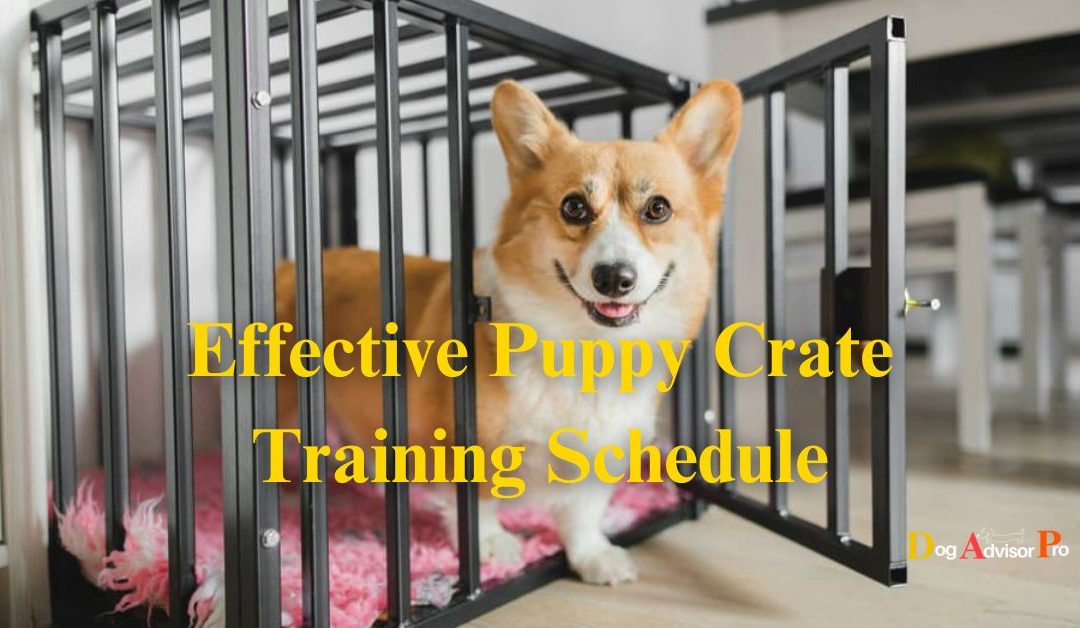Are you ready to learn how to teach your puppy to behave better? If so, you’re where you need to be. In this guide, I’ll talk about how to do Puppy Crate Training for staying in a crate. Even though it sounds weird, it can make your dog happy and better behaved. I’ll explain why crate training is a good idea, why you should start early, and how to do it.
Giving your dog a crate is like giving it a warm bedroom. It gives them a sense of safety and security. I’ll discuss why it’s a good idea and how it can make your puppy happy.
It’s essential to start early so that your dog can learn good habits. I’ll tell you why you should begin training your puppy when they are still young.
I’ll give you a step-by-step plan to teach your puppy to love its Crate as I go along. Also, talk about everything, from choosing the right Crate to getting your puppy used to being in it. It’s all about making sure your dog is comfortable and at ease.
So, let’s get started.
First, I’ll discuss crate training and how it can help your puppy.
Crate Training And Its Benefits For Puppies
Crate training is more than just putting your puppy in a small area; it’s a great way to help them learn, grow, and give you peace of mind. Some of the perks are:
- Safety: A box gives your puppy a safe place to stay when you can’t watch it, so it doesn’t get into situations that could be dangerous.
- Housebreaking: It helps housebreaking by teaching your dog to hold their urine and poop.
- Security: The Crate turns into a place that looks like a den where your puppy can feel safe and calm down.
- Travel Convenience: Traveling with crate-trained puppies is easier because they are more comfy. This makes trips to the vet less stressful.
Then, I’ll discuss why it’s crucial to begin crate training from a young age.
Why It’s Important To Start Crate Training Early
It’s essential to start Crate training your puppy as soon as possible for several reasons:
- Adaptability: Puppies are more flexible when they are young, which makes it easier for them to accept the Crate as part of their surroundings.
- Pattern: Crate training helps your puppy learn when to eat, sleep, and play by setting up a practice.
- Reducing Anxiety: If you start box training your dog early, it will learn to be OK with being alone.
- Avoiding Bad Habits: It stops terrible habits like eating furniture or having accidents inside from starting.
Let’s have a look at the Puppy Crate Training Timetable.
Puppy Crate Training Schedule
Sure, there’s a simpler version of a puppy crate training schedule:
Week 1: Getting Used To The Crate
Days 1-2: Introduction
- Put the Crate in a quiet spot.
- Leave the crate door open so your puppy can check it out.
- Put a soft blanket or bed inside.
Days 3-4: Eating And Treats
- Start feeding your puppy near the Crate.
- Move the food bowl closer to the Crate each time.
- Give your puppy treats for going inside the Crate.
Days 5-7: Short Times In The Crate
- Begin closing the crate door for a few minutes while you’re there.
- Make the time longer each day.
- Use treats and praise when your puppy goes in and out.
Week 2: Becoming Friends With The Crate
Days 8-14: More Time In The Crate
- Keep doing short crate sessions, but make them 15-20 minutes long.
Week 3: Time Alone In The Crate
Days 15-21: Crate Alone Time
- Leave your puppy in the crate when you’re home, but do not play with them.
- Make the time longer, up to an hour.
- Please don’t make a big fuss when you return; wait for your puppy to calm down before letting them out.
Week 4: Learning To Be Independent
Day 22+: More Independence
- Start leaving your puppy in the Crate when you go out.
- Begin with short trips and make them longer over time.
- Give your puppy toys and safe things to chew on.
- Keep a regular schedule for crate time and potty breaks.
Tips:
- Don’t use the Crate as a punishment.
- Keep the Crate clean and comfy.
- Don’t leave your puppy in the Crate too long without potty breaks (follow the one hour per month of age rule).
- Be patient and use treats and praise to reward good behavior.
Remember, crate training takes time, but it helps your puppy feel safe and happy in their Crate. Stick with it, and your puppy will learn to love their special den!
Now, I’ll explore the secrets to making crate time fun for your puppy.
How To Teach Your Puppy To Love Being In The Crate (A Step-By-Step Guide)
Crate training is a valuable tool for both puppies and owners. It helps with housebreaking, provides a safe space for your pup, and can prevent destructive behavior. However, not all puppies love their crates immediately.
Here’s a step-by-step guide to help your puppy learn to love their crate:
Step 1: Make the Crate Appealing
- Location: Place the crate in a quiet, comfortable area with low foot traffic. Avoid placing it in areas with drafts or loud noises.
- Comfort: Make the crate comfortable with bedding like soft blankets or towels. You can also add a special chew toy or Kong stuffed with treats.
- Positive association: Leave the crate door open when you’re not using it, allowing your puppy to explore it freely. You can also place treats inside the crate to encourage them to go in.
Step 2: Introduce the Crate with Play and Mealtime
- Playtime: Toss toys into the crate and encourage your puppy to chase them inside. You can also play games where they must go in and out of the crate.
- Mealtime: Start feeding your puppy their meals inside the crate. This creates a positive association with the crate, where they receive good things.
Step 3: Gradually Increase Crate Time
- Short sessions: Start with short periods in the crate, like 5-10 minutes, gradually increasing the duration as your puppy gets comfortable.
- Stay nearby: Sit quietly beside the crate while your puppy is inside. Talk to them in a soothing voice and offer treats through the bars.
- Leave and return: Once your puppy is comfortable with short crating sessions, leave the room briefly and return calmly. Gradually increase the length of time you’re away.
Step 4: Practice Crate Time During Routine Activities
- Nap time: Encourage your puppy to nap in their crate during their usual nap times. This helps them associate the crate with relaxation and calmness.
- Before bedtime: Make crate time part of your bedtime routine. Put your puppy in their crate with a special toy or treat and say goodnight in a calming voice.
- Leaving the house: When you leave, crate your puppy to prevent accidents and destructive behavior. Start with short outings and gradually increase the duration as your puppy gets comfortable.
Remember, the key to successful crate (potty) training is patience and positive reinforcement. Your puppy will learn to love and enjoy their crate with time and effort.
Accidents in the Crate Can Be Avoided From Here On Out
How To Prevent Accidents In The Crate
Accidents in the Crate can be annoying, but they’re not impossible. Here are some things you can do to stop them:
- First, ensure your puppy goes to the bathroom before putting them in the Crate. Take them outside and wait for them to do what they need to do.
- Second, get a box the right size, both too big and too small. Dogs like to have a clean place to sleep.
- Lastly, eat and go to the bathroom simultaneously every day. This will help your puppy get used to a schedule and keep the Crate clean and comfortable.
Below are frequently asked questions about the most efficient puppy crate training schedule.
F.A.Q.a On Effective Puppy Crate Training Schedule
How Do You Train A Puppy To Use A Box In 3 Days?
Teaching a puppy to use a crate in three days is hard, but it is possible. You’ll need to introduce the Crate slowly, make it a happy place, and give your puppy time to get used to it. The key is to be patient and consistent.
Is It OK to Let A Puppy Cry All Night In A Crate?
Letting your puppy cry often in the Crate at night is not a good idea. Puppies bark when they need to go to the bathroom or are scared. You should check on them and make the Crate comfortable. Over time, they’ll get used to it and cry less.
How Do I Stop My Puppy From Crying When He’s In His Crate?
To stop your puppy from crying in the Crate, you must meet its immediate wants and make it a comfortable place. This means seeing if they need to go pee, making them feel better in the crate, and showing them that the crate is okay. If you stick to a pattern, it will help them feel more safe, which should make them cry less.
Final Suggestions
Ultimately, sensible dog cage training is essential for a good pet owner. It has many perks, and the key to success is to start early. Using the whole crate training plan and my expert tips, you can teach your puppy to love their box and have a happy, well-behaved friend.
Review of the main points:
- Training your puppy in a crate is safe, secure, and easy for both.
- Starting early gives you a pattern, lowers your stress, and keeps you from getting into bad habits.
- The plan for crate training includes picking the correct box, introducing it slowly, and being patient.
- Ensure the right size, take breaks often, and keep things clean.
- FAQs answer common questions about box training.
Remember that every dog is different, and the way to train each may differ. If you are patient, your dog will learn to love their Crate.
Please let me know if you have any queries about dog training.

Hello, I’m Ethan Mitchell. My passion is dog training and behavior enthusiasts. With years of experience working with various breeds, my goal at Dog Advisor Pro is to help dog owners build strong, loving relationships with their furry friends through effective training techniques. Understanding a dog’s behavior is the key to harmonious companionship. I am dedicated to sharing practical training tips that improve the lives of dogs and their owners.


